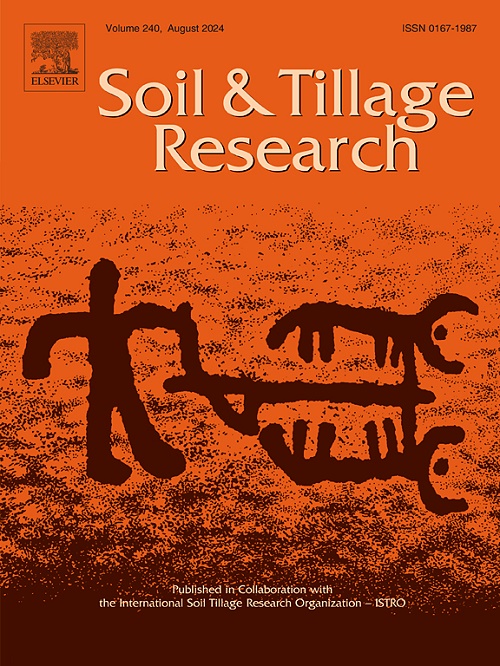Regional maize suitability based on soil water and salt content inversion by integrating machine and transfer learnings in Xinjiang
IF 6.1
1区 农林科学
Q1 SOIL SCIENCE
引用次数: 0
Abstract
Soil water content (SWC) and salt content (SSC) are critical factors affecting maize growth. Remote sensing technology has become an effective tool for regional SWC and SSC estimation, but challenges remain in improving estimation accuracy and cross-scale model transfer. In this study, the feature sets were optimized using correlation clustering analysis and full subset selection, and five machine learning models, including the bat-optimized random forest (BA-RF), were compared to estimate SWC and SSC. Further, the inversion model constructed based on UAV features was transferred to satellite scale using transfer component analysis (TCA) and its accuracy was verified. The key findings were as follows: (1) Feature optimization improved estimation accuracy (SWC: R2≥0.541, RMSE≤0.021 cm3 cm–3; SSC: R2≥0.574, RMSE≤0.816 g kg–1). (2) The BA-RF model achieved high estimation performance for SWC (R2 = 0.705–0.899, RMSE = 0.010–0.020 cm3 cm–3) and SSC (R2 = 0.700–0.897, RMSE = 0.466–0.737 g kg–1). (3) TCA enabled effective transfer of the BARF-TCA model from UAV to satellite scale, maintaining a high estimation accuracy (SWC: R2 ≥ 0.764 RMSE ≤ 0.015cm3 cm–3, SSC: R2 ≥ 0.667, RMSE≤ 0.672 g kg–1). (4) A water-salinity suitability index was developed to generate dynamic maize suitability maps across growth stages. This study presented an integrated framework for large-scale, high-precision estimation of SWC and SSC, as well as water-salinity-based crop suitability zoning, providing valuable guidance for maize farmland SWC and SSC management in arid and saline-alkaline regions.
基于机器与迁移学习相结合的新疆土壤水盐含量区域玉米适宜性研究
土壤含水量和含盐量是影响玉米生长的关键因素。遥感技术已成为区域SWC和SSC估算的有效工具,但在提高估算精度和跨尺度模型迁移方面仍存在挑战。在本研究中,使用相关聚类分析和全子集选择对特征集进行优化,并比较了包括蝙蝠优化随机森林(BA-RF)在内的五种机器学习模型来估计SWC和SSC。利用传递分量分析(TCA)将基于无人机特征构建的反演模型转移到卫星尺度,验证了模型的精度。主要研究结果如下:(1)特征优化提高了估计精度(SWC: R2≥0.541,RMSE≤0.021 cm3 cm-3;SSC: R2≥0.574,RMSE≤0.816 g kg-1)。(2) BA-RF模型对SWC (R2 = 0.705 ~ 0.899, RMSE = 0.010 ~ 0.020 cm3 cm-3)和SSC (R2 = 0.700 ~ 0.897, RMSE = 0.466 ~ 0.737 g kg-1)具有较高的估计性能。(3) TCA实现了BARF-TCA模型从无人机到卫星尺度的有效转移,保持了较高的估计精度(SWC: R2≥0.764 RMSE≤0.015cm3 cm-3, SSC: R2≥0.667,RMSE≤0.672 g kg-1)。(4)建立了水盐适宜性指数,生成了玉米各生育期的动态适宜性图。本研究为干旱盐碱区玉米农田SWC和SSC的大尺度、高精度估算及基于水盐的作物适宜性区划提供了综合框架,为干旱盐碱区玉米农田SWC和SSC管理提供了有价值的指导。
本文章由计算机程序翻译,如有差异,请以英文原文为准。
求助全文
约1分钟内获得全文
求助全文
来源期刊

Soil & Tillage Research
农林科学-土壤科学
CiteScore
13.00
自引率
6.20%
发文量
266
审稿时长
5 months
期刊介绍:
Soil & Tillage Research examines the physical, chemical and biological changes in the soil caused by tillage and field traffic. Manuscripts will be considered on aspects of soil science, physics, technology, mechanization and applied engineering for a sustainable balance among productivity, environmental quality and profitability. The following are examples of suitable topics within the scope of the journal of Soil and Tillage Research:
The agricultural and biosystems engineering associated with tillage (including no-tillage, reduced-tillage and direct drilling), irrigation and drainage, crops and crop rotations, fertilization, rehabilitation of mine spoils and processes used to modify soils. Soil change effects on establishment and yield of crops, growth of plants and roots, structure and erosion of soil, cycling of carbon and nutrients, greenhouse gas emissions, leaching, runoff and other processes that affect environmental quality. Characterization or modeling of tillage and field traffic responses, soil, climate, or topographic effects, soil deformation processes, tillage tools, traction devices, energy requirements, economics, surface and subsurface water quality effects, tillage effects on weed, pest and disease control, and their interactions.
 求助内容:
求助内容: 应助结果提醒方式:
应助结果提醒方式:


